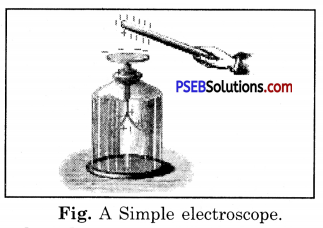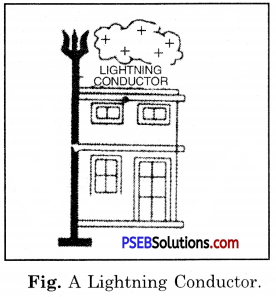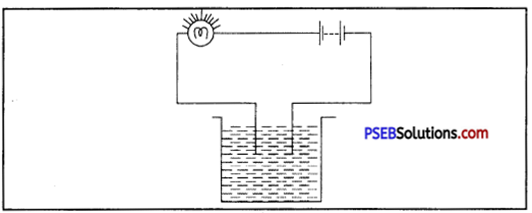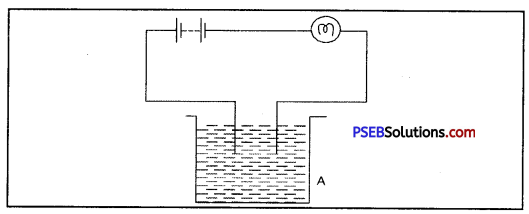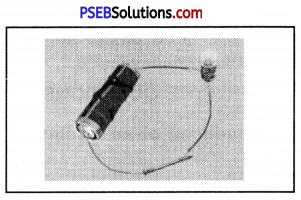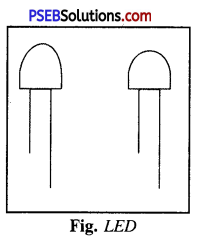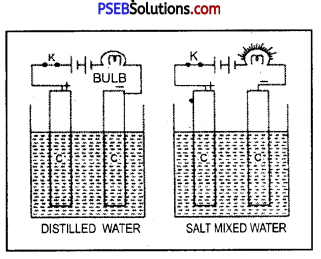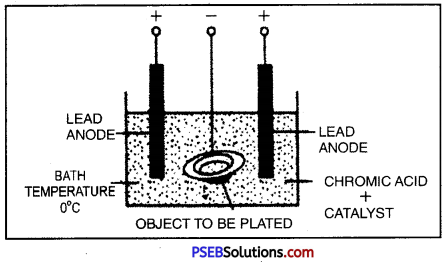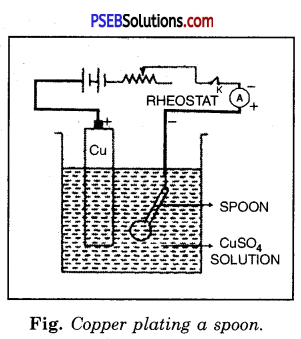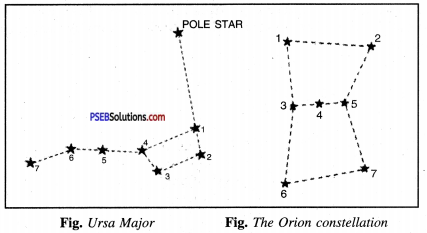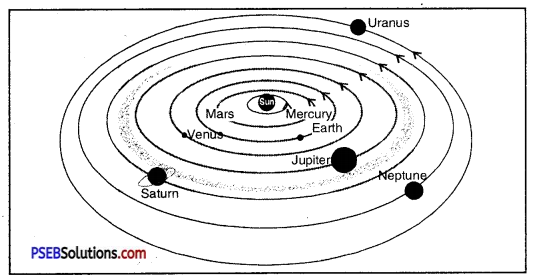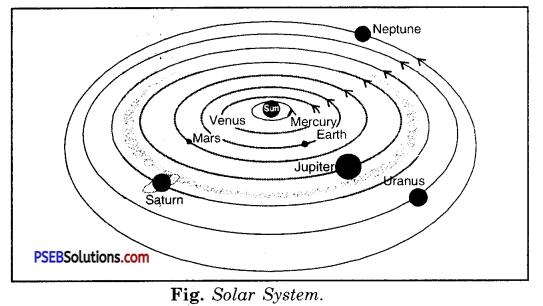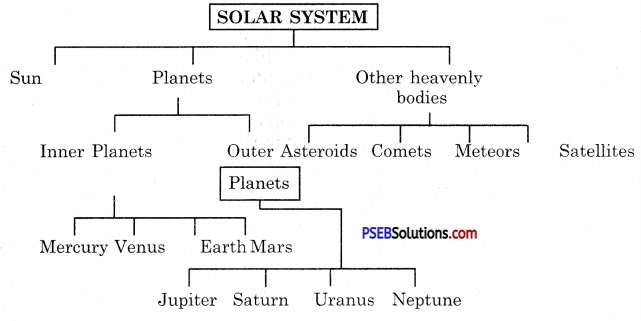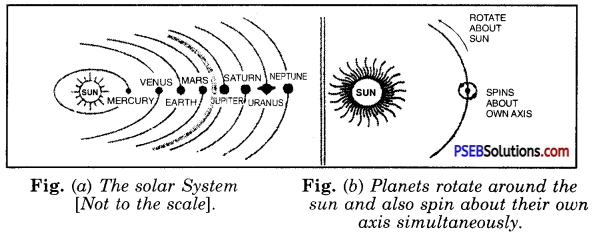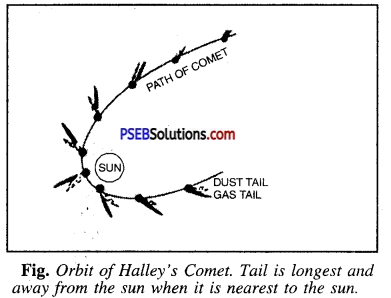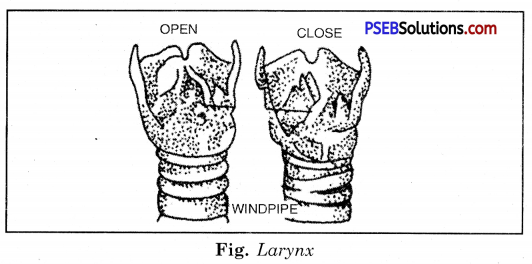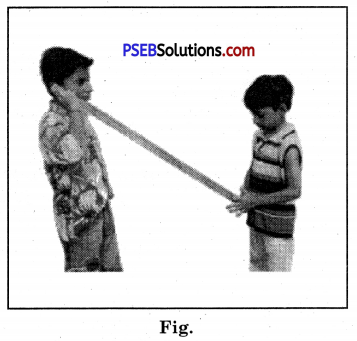Punjab State Board PSEB 8th Class Social Science Book Solutions Civics Chapter 24 Constitution and Law Textbook Exercise Questions and Answers.
PSEB Solutions for Class 8 Social Science Civics Chapter 24 Constitution and Law
SST Guide for Class 8 PSEB Constitution and Law Textbook Questions and Answers
I. Fill in the blanks :
Question 1.
The constitution of India was implemented on ___________
Answer:
26 Jan. 1950
Question 2.
___________ was the first President of India.
Answer:
Dr. Rajendra Prasad
Question 3.
The law against Dowry was enacted in ___________
Answer:
1961 A.D.
Question 4.
The Constitution of India was prepared in ___________ years months and days.
Answer:
2,11,18
![]()
Question 5.
The main cause of foeticide is ___________custom.
Answer:
dowry.
II. Put a tick against the Right (✓) and a cross against the wrong (✗) answer:
Question 1.
Gandhiji broke the salt law at Dandi.
Answer:
(✓)
Question 2.
The Judiciary does not protected the constitution.
Answer:
(✗)
Question 3.
The rule of law runs through India.
Answer:
(✓)
Question 4.
To oppose bad laws is the feature of Democracy.
Answer:
(✓)
Question 5.
Laws are Indefinite rules.
Answer:
(✗)
III. Multiple Choice Questions :
Question 1.
When was the Indian Constitution Implement?
(A) Nov. 26, 1949
(B) Jan. 26, 1950
(C) Jan. 26, 1930
(D) Jan. 26, 1949.
Answer:
(B) Jan. 26, 1950.
Question 2.
Who was the Chairman of the constitution draft committee?
(A) Dr. Rajinder Prasad
(B) Dr. B.R. Ambedkar
(C) Mahatma Gandhi
(D) Pandit Jawahar Lai Nehru.
Answer:
(B) Dr. B.R. Ambedkar.
![]()
Question 3.
Who is the highest of the following in India?
(A) Prime Minister
(B) President
(C) Judiciary
(D) Constitution.
Answer:
(D) Constitution.
Question 4.
State the number of draft committee members.
(A) 11
(B) 18
(C) 7
(D) 2.
Answer:
(C) 7.
IV. Answer the following questions In not more than 15 words :
Question 1.
What do you mean by Constitution?
Or
Write the meaning of the term Constitution.
Answer:
The Constitution is a legal document through which administration of the country is being run. Central and state governments run their administration according to the Constitution. The Constitution is above of all the laws of the country.
Question 2.
Why was Constitution implemented on 26th January, 1950?
Answer:
Our Constitution was implemented on 26th January, 1950 because of the historical importance of this date. On 26th January, 1930, first independence day of the country was celebrated.
Question 3.
Write the word meaning of Law.
Answer:
Law is an English word. The word “Law’ came out of Tutonic word ‘Lag’ whose meaning is definite. In this way the meaning of law is definite rule.
![]()
Question 4.
What is the importance of Law?
Answer:
Law is helpful in maintaining system of any institution or the country. No institution can run in a proper way without the laws. School also has its own laws (rules) with which discipline is maintained in the school.
Question 5.
What do you mean by the impartial Judiciary?
Answer:
The meaning of impartiality of the judiciary is that it works independently without the pressure of executive or legislative. Judiciary in India also has been made impartial. If any institution does not work according to the Constitution, judiciary can declare it unconstitutional.
Question 6.
Which were the movements started by Mahatma Gandhi?
Answer:
Mahatma Gandhiji started Non-Cooperation Movement in 1921, Civil Disobedience Movement in 1930 and Quit India Movement in 1942 A.D.
Question 7.
What do you understand by “Boycott of Liquor”?
Or
What is meant by the prohibition of Liquor?
Answer:
The meaning of Boycott of Liquor is restriction of making whisky by state, sale of whisky and drinking of whisky.
V. Answer the following questions in 50-60 words :
Question 1.
What do you mean by the. supremacy of the Constitution?
Answer:
The Indian Constitution is considered as the highest document.
- Persons being appointed in all the important offices of the country are asked to take the oath of the Constitution.
- All government and non-government institutions work according to the Constitution.
- Judiciary has been made independent and impartial. It has been given a number of rights for the security of the Constitution. Out of these, one right is related to” security and explanation of the Constitution.
- A democratic structure has been established in the country according to the Constitution. Citizens are given a number of rights. One of these important rights is the right to criticise the government.
Question 2.
How was the Constitution of India formed?
Answer:
On the 29th of August, 1947, a seven member committee was formed to form the Indian Constitution. This committee studied the Constitutions of many countries. It took 2 years, 11 months and 18 days to complete the Indian Constitution. It was passed by the Constituent Assembly on 29th November, 1949 but was implemented in the country on 26th January, 1950 due to the historical importance of this date.
Question 3.
How has the judiciary been made Impartial in India?
Answer:
Judiciary has been made the independent and unbiased for the security of Constitution. Judiciary determines that the Constitution should be obeyed. If any institution does not work according to the Constitution then it can be declared as unconstitutional. Judiciary has the right to review the laws. It means that if any law made by legislative is against the spirit of the Constitution, it can be dismissed by the Judiciary. In the same way if any work implemented by executive is against the Constitution then it can be declared as unconstitutional.
Question 4.
Why did Gandhi violate the British laws?
Answer:
The British government used to make laws for the country before our independence. The main aim of these laws was to meet the interests of the British government. Indian interests were hardly cared by these laws. For example, British government passed an act in 1919 A.D. called Rowlatt Act according to which government was free to arrest any person just on the basis of doubt. Salt law was also against Indians. It was necessary to break such laws. That’s why Gandhiji broke those laws.
![]()
Question 5.
What is meant by prohibition and why should it be put into practice?
Answer:
Meaning of boycotting of liquor is the legal prohibition of making whisky, sale of whisky and drinking of whisky.
Drinking whisky or alcohol is a social evil. According to one survey, every fourth person of the country is alcoholic. Daily 25 crore rupees are being spent on whisky. Not only this it leads to loss of money, loss of health and loss of time. Alcohol takes the person towards moral degradation. That’s why it is necessary to implement the policy of Complete Prohibition.
PSEB 8th Class Social Science Guide Constitution and Law Important Questions and Answers
Multiple Choice Questions :
Question 1.
Indian Constitution was framed by :
(a) Indian Parliament
(b) Dr. Ambedkar British
(c) Constituent Assembly
(d) Parliament.
Answer:
(c) Constituent Assembly.
Question 2.
The Indian Constitution was enforced on :
(a) 9th December 1950
(b) 15th August 1947
(c) 26th Nov. 1949
(d) 26th January, 1950.
Answer:
(d) 26th January, 1950.
Question 3.
Aims of the Constitution are mentioned in the :
(a) Preamble
(b) Fundamental Rights
(c) Directive Principles
(d) None of the above.
Answer:
(a) Preamble
![]()
Question 4.
Who was the Chairman of the Drafting Committee of the Constituent Assembly?
(a) Dr. B.R. Ambedkar
(b) Pt. Jawaharlal Nehru
(c) Dr. Rajinder Prasad
(d) K.M. Munshi.
Answer:
(a) Dr. B.R. Ambedkar.
Question 5.
Which of the following right is available under the Indian Constitution?
(a) Right to Equality
(b) Right to Freedom
(c) Right against Exploitation
(d) All the above.
Answer:
(d) All the above.
Question 6.
At present Indian citizen enjoys :
(a) Seven Fundamental Rights
(b) Eight Fundamental Rights
(c) Six Fundamental Rights
(d) None of the above
Answer:
(c) Six Fundamental Rights.
Question 7.
Who was elected as the first president of India?
(a) Dr. Rajendra Prasad
(b) Pt. Jawahar Lai Nehru
(c) Sardar Patel
(d) Mahatma Gandhi.
Answer:
(a) Dr. Rajendra Prasad.
Question 8.
Which of these movements was started by Gandhiji?
(a) Non-Cooperation Movement
(b) Quit India Movement
(c) Civil Disobedience Movement
(d) All of these.
Answer:
(d) All of these.
![]()
Question 9.
When was Dowry Prohibition Act passed?
(a) 1960
(b) 1961
(c) 1962
(d) 1963.
Answer:
(b) 1961.
Fill in the Blanks :
Question 1.
Indian Constitution come into force on ___________
Answer:
26 January 1950
Question 2.
___________ was the first President of India.
Answer:
Dr. Rajendra Prasad
Question 3.
Dowry Prohibition Act was passed in A.D.
Answer:
1961
Question 4.
Indian Constitution was made in around ___________ years.
Answer:
Three
![]()
Question 5.
Major reason of foeticide is ___________
Answer:
Dowry.
Tick the Right (✓) or Wrong (✗) Answer:
Question 1.
Gandhi Ji broke Salt Law at Dandi.
Answer:
(✓)
Question 2.
Judiciary never protects the country.
Answer:
(✗).
Question 3.
Rule of law is there in India.
Answer:
(✓)
Question 4.
Elimination of wrong laws is a basic aspect of democratic government.
Answer:
(✓)
![]()
Question 5.
Laws are indefinite rules.
Answer:
(✗).
Match the Following :
Question 1.
| A | B |
| 1. Constitution | (i) Judiciary |
| 2. Protection of Constitution | (ii) 31 Dec. 1929 |
| 3. Completion of Constitution | (iii) Legal Document |
| 4. Declaration of Poorna Swaraj | (iv) 26 Nov. 1949 |
Answer:
| A | B |
| 1. Constitution | (iii) Legal Document |
| 2. Protection of Constitution | (i) Judiciary |
| 3. Completion of Constitution | (iv) 26 Nov. 1949 |
| 4. Declaration of Poorna Swaraj | (ii) 31 Dec. 1929 |
Very Short Answer Type Questions
Question 1.
When did India become independent?
Answer:
India became independent on 15th August 1947.
Question 2.
Who framed the Constitution of India? Who was its chairman?
Answer:
The Constitution of India was framed by the Constituent Assembly whose chairman was Dr. Rajendra Prasad.
Question 3.
When was the Drafting Committee of the Constituent Assembly framed? Who was its Chairman?
Answer:
The Drafting Committee of the Constituent Assembly was framed on 29th August 1947. Its chairman was Dr. B.R. Ambedkar.
![]()
Question 4.
Who was the first President of India? In which meeting of Constituent Assembly he was elected as President?
Answer:
The first President of India was Dr. Rajendra Prasad. He was elected as the President in the last meeting of Constituent Assembly on 25th January 1950.
Question 5.
Which steps are taken to make Judiciary independent and impartial?
Answer:
Appointment of judges, their salary, perks and term are kept separate from other bureaucrats.
Question 6.
Give two things included in the Civil Disobedience and Non-Cooperation Movements.
Answer:
- Not to use things made by the British government.
- Not to wear clothes made by them.
Question 7.
Where and how was the salt law broken?
Answer:
Salt law was broken at Dandi (Gujarat) under the leadership of Mahatma Gandhi. Salt made by the British government was destroyed by them and Gandhiji ordered to make salt themselves from the seawater.
Question 8.
Which state governments passed the laws related to complete prohibition? Were they proved fruitful?
Answer:
Complete Prohibition Laws were passed by governments of Gujarat, Haryana, Kerala and Andhra Pradesh. But they were not proved fruitful.
Short Answer Type Questions
Question 1.
Write a note on the formation and implementation of the Constitution of India.
Answer:
After the independence, one Constituent Assembly was formed. Dr. Rajendra Prasad was elected its permanent chairman. This committee was sovereign in its hands.
Formation of Drafting Committee and making of the Constitution. One committee of seven members was formed on 29th August, 1947 to give definite form to the Constitution. It’s chairman was Dr. B.R. Ambedkar. This Drafting Committee studied the Constitutions of different countries and collectecLmany facts from the Constitutions of other countries. Total 11 meetings of the Constituent Assembly were held. The work of making of the Constitution was completed on 26 Nov., 1949. It took 2 years, 11 months and 18 days to make our Constitution. The Constitution was implemented on 26th Jan. 1950. Last meeting of Constituent Assembly took place on 25th Jan. 1950 in which Dr. Rajendra Prasad was elected as the first President, of India.
![]()
Question 2.
Why and how Dowry System was banned?
Answer:
The custom of dowry was a curse on our society. This was one of the biggest problems for poor classes right from the ages. Poor people used to take loan to give dowry to their girls. It led to lower status of females in society. That’s why people started to encourage female foeticide. It led to decline in sex-ratio in society. That’s why government was forced to make a law to restrict dowry system and this law was made in 1961. According to this law, giving or taking dowry is an offence.
Question 3.
What do you mean by the Constitution and Law?
Answer:
Constitution. The Constitution is a fundamental and legal document which enjoys the highest place in the country. It is a set of those rules according to which administration of the country is being run. All the government and non-government institutions work according to the Constitution.
Law. Law is that rule which maintains peace and order in the country. Laws are being formed by central and state legislatures. It is necessary for all the citizens of the country to obey the laws of the country. Punishment can be given in case of breaking the laws.
Question 4.
What is the meaning and importance of Law?
Answer:
Meaning. Law is an English word. The word ‘Law’ came out of the Teutonic word ‘Lag” whose meaning is definite. In this way, the meaning of the word ‘Law’ is any definite rule.
Importance of Law: Laws are of great importance in social life. They regulate our social life. Our social life cannot run in a proper way without these laws. For example, if rules (laws) will not be implemented in the school then indiscipline will not prevail in the school. In this way, if criminals will not be controlled by laws then insecurity will prevail in the social life of the society.
![]()
Question 5.
List the rights of citizens in a criticism.
Answer:
Rights given to citizens by the Constitution are known as basic rights or fundamental rights. They are six in number and are listed as follows:
- Right to Equality.
- Right to Freedom.
- Right against Exploitation.
- Right to Religious Freedom.
- Cultural and Educational Rights.
- Right to Constitutional Remedies.


